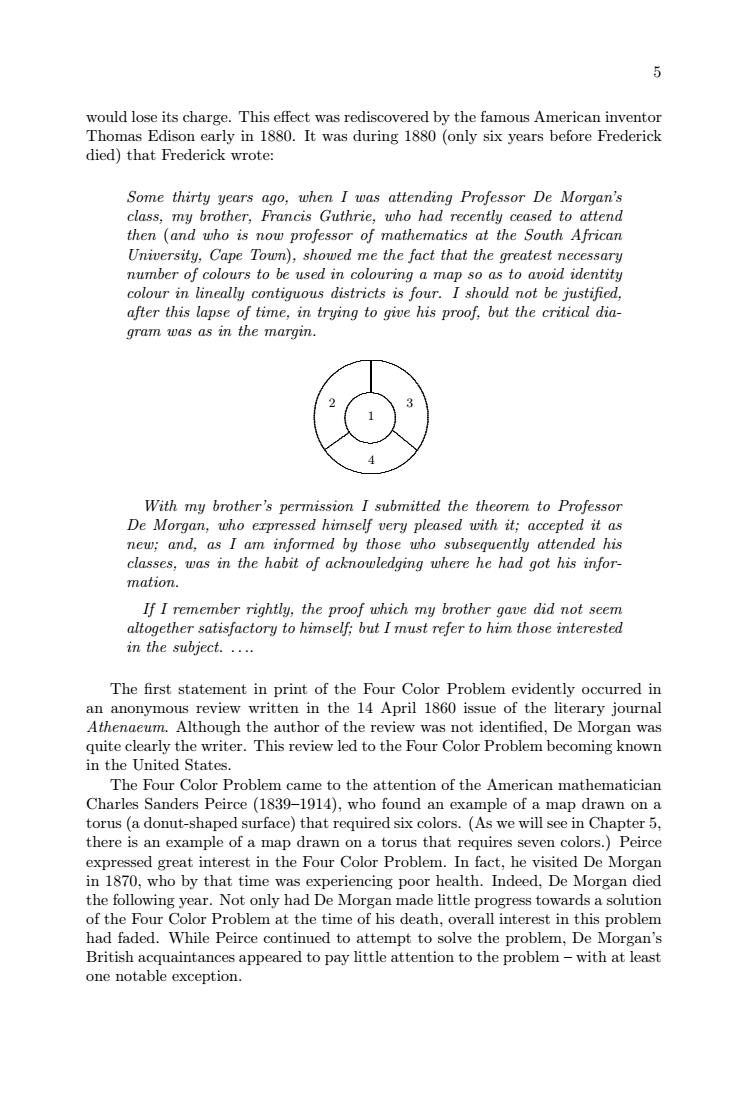正在加载图片...

would lose its charge.This effect was rediscovered by the famous AmericanThomas Edison early in1880.It was during1880 (only six years beforeFrederickdied) that Frederick wrote:Some thirty years ago, whenI was attendingProfessor De Morgan'sclass, my brother,Francis Guthrie, who had recently ceased to attendthen(and who is nowprofessor of mathematics at the SouthAfricanUniversity, Cape Town), showed me the fact that the greatest necnumber of colours to be used in colouring a map so as to avoid identitycolour in lineally contiguous districts is fofour.I should notbejustifiedafter this lapse of time, in trying to give his proof, but the critical dia-gram was as in the marginWith my brother's permission I submitted the theorem to ProfessorDe Morgan, who erpressed himnself very pleased with it; accepted it asnew; and, as I am informed by those who subsequently attended hisclasses, was in the habit of acknowledging where he had got his infor-mation.If I remember rightly, the proof which my brother gave did not seenaltogether satisfactory to himself; but Imust refer to him those interestedin the subject. ....Thefirst statementin print of theFour ColorProblem evidentlyoccurredinan anonymous review written in the 14 April 1860 issue of the literary journalAthenaeum. Although the author of the review was not identified, De Morgan wasquite clearly the writer. This review led to the Four Color Problem becoming knownin the United StateTheFourColorProblemcametotheattentionoftheAmericanmathematicianCharles Sanders Peirce (1839-1914),who found an example of a map drawn on atorus (a donut-shaped surface)that required six collors.(AswewillseeinChapter5)there isan exampleofamapdrawnonatorusthatrequiressevencolors.)Peirceerest in the Four Color Problem. In fact, he visited De Morganorein70,whobythat time wasexperiencingoorhealthIndeedeMorgandedthefllowing year.Not only hadDe Morganmadelttleprogresstowardsasolutionof the Four Color Problem at the time of his death, overall interest in this problemhad faded.While Peirce continued to attempt to solve the problem, De Morgan'sBritish acquaintancesappeared topaylittleattentiontotheproblem-withatleastone notableexception5 would lose its charge. This effect was rediscovered by the famous American inventor Thomas Edison early in 1880. It was during 1880 (only six years before Frederick died) that Frederick wrote: Some thirty years ago, when I was attending Professor De Morgan’s class, my brother, Francis Guthrie, who had recently ceased to attend then (and who is now professor of mathematics at the South African University, Cape Town), showed me the fact that the greatest necessary number of colours to be used in colouring a map so as to avoid identity colour in lineally contiguous districts is four. I should not be justified, after this lapse of time, in trying to give his proof, but the critical diagram was as in the margin. . . .. .. ... ... ..... ...... ...... ......... ............ ................... ............ ........ ........ ....... ..... ..... ... .... .. .... .............................................................................................................................. . .. ... ...... ......... ............. ....... .... ...... .... .. . ........................................................ .................................. .............................. 1 4 2 3 With my brother’s permission I submitted the theorem to Professor De Morgan, who expressed himself very pleased with it; accepted it as new; and, as I am informed by those who subsequently attended his classes, was in the habit of acknowledging where he had got his information. If I remember rightly, the proof which my brother gave did not seem altogether satisfactory to himself; but I must refer to him those interested in the subject. . . .. The first statement in print of the Four Color Problem evidently occurred in an anonymous review written in the 14 April 1860 issue of the literary journal Athenaeum. Although the author of the review was not identified, De Morgan was quite clearly the writer. This review led to the Four Color Problem becoming known in the United States. The Four Color Problem came to the attention of the American mathematician Charles Sanders Peirce (1839–1914), who found an example of a map drawn on a torus (a donut-shaped surface) that required six colors. (As we will see in Chapter 5, there is an example of a map drawn on a torus that requires seven colors.) Peirce expressed great interest in the Four Color Problem. In fact, he visited De Morgan in 1870, who by that time was experiencing poor health. Indeed, De Morgan died the following year. Not only had De Morgan made little progress towards a solution of the Four Color Problem at the time of his death, overall interest in this problem had faded. While Peirce continued to attempt to solve the problem, De Morgan’s British acquaintances appeared to pay little attention to the problem – with at least one notable exception